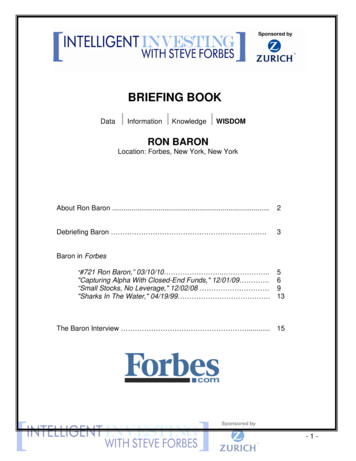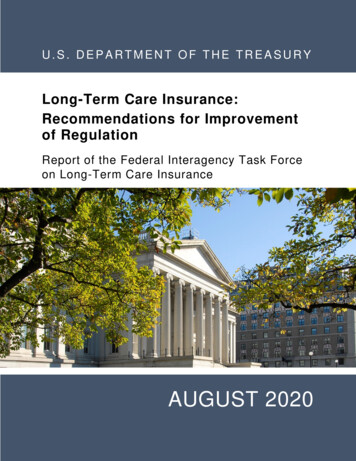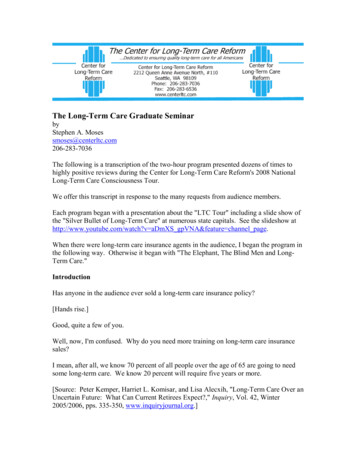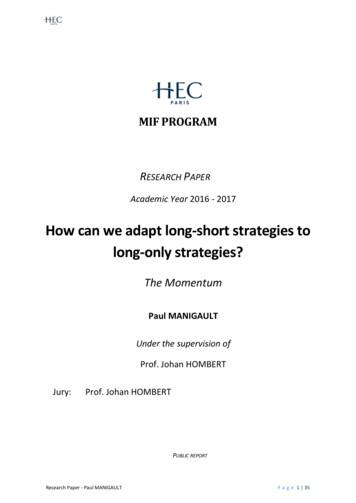
Transcription
Long-Term Investing Strategiesin Private Wealth ManagementJuly 2012Noël AmencProfessor of Finance, Edhec Business Schooland Director, EDHEC-Risk InstituteRomain DeguestSenior Research Engineer, EDHEC-Risk InstituteLionel MartelliniProfessor of Finance, EDHEC Business Schooland Scientific Director, EDHEC-Risk InstituteVincent MilhauDeputy Scientific Director,EDHEC-Risk Institute
AbstractWe argue in this paper that improved long-term investing strategies can be designed for privatewealth management. These dynamic allocation strategies exploit the presence of mean-reversionin interest rates, equity Sharpe ratio and equity volatility. The resulting asset allocation strategy isbased on an industrialization of three key paradigms that have recently emerged in institutionalmoney management: liability-driven investing (LDI), for taking into account private clients’consumption objectives, life-cycle investing (LCI), for taking into account private clients’ horizon,and risk-control investing (RCI), for taking into account private clients’ risk budgets. Our MonteCarlo experiments reveal a substantial benefit in terms of utility gains from using improved longterm investing strategies over existing industry standards.JEL code: D91, G11EDHEC is one of the top five business schools in France. Its reputation is built on the high qualityof its faculty and the privileged relationship with professionals that the school has cultivatedsince its establishment in 1906. EDHEC Business School has decided to draw on its extensiveknowledge of the professional environment and has therefore focused its research on themes thatsatisfy the needs of professionals.2EDHEC pursues an active research policy in the field of finance. EDHEC-Risk Institute carries outnumerous research programmes in the areas of asset allocation and risk management in both thetraditional and alternative investment universes.Copyright 2012 EDHEC
1. Introduction: Asset-Liability Management in Private Wealth ManagementAsset-liability management (ALM) denotes the adaptation of the portfolio management processin order to handle the presence of various constraints relating to the commitments that representthe liabilities of an investor. Academic research has suggested that suitable extensions of portfoliooptimization techniques used by institutional investors, e.g., pension funds, would be usefullytransposed to the context of private wealth management because they have been preciselyengineered to allow for the incorporation in the portfolio construction process of investors’ specificconstraints, objectives and horizons, all of which can possibly be summarized in terms of a singlestate variable -the value of the “liability” portfolio (see Amenc et al. (2009) for a recent reference).It should be noted at this stage that within the framework of private wealth management, weuse a broad definition of “liabilities”, which encompasses any commitment or spending objective,typically self-imposed (as opposed to exogenously imposed as in a pension fund context), thatinvestors are facing. Overall, it is not the performance of a particular fund nor that of a given assetclass that will be the determinant factor in the ability to meet private investor’s expectations.The success or failure of the satisfaction of the investor’s long term objectives is fundamentallydependent on an ALM exercise that aims at determining the proper strategic inter-classes allocationas a function of the investor’s specific objectives and constraints, in addition to the investor’stime-horizon. In other words, what will prove to be the decisive factor is the ability to design anasset allocation solution that is a function of the risks to which the investor is exposed, as opposedto the market as a whole.In a recent survey about best practices in private wealth management, Amenc et al. (2010) findthat private asset-liability management is perceived as a promising concept for integrating clientspecific objectives but it is still underused.1 More precisely, the survey reports that private wealthmanagers who are unfamiliar with ALM and those who are familiar with it (but do not use it) makeup the majority of the respondents to the survey. A large majority of those who are familiar withALM techniques but do not currently use them actually consider them useful, so the failure toadopt ALM in private wealth management as widely as in institutional investment managementhas more to do with unfamiliarity with the concept and with the perceived difficulty of using itthan with sceptical views on its usefulness. Only 57% of the 52% of respondents who are familiarwith ALM actually use it to allocate assets -a figure that means that, overall, only one-third ofrespondents actually use ALM. Private wealth managers focus mainly on general inflation ratherthan on inflation specific to client objectives, so ALM is largely seen as a way of hedging against“typical” liabilities; optimal practice would, in principle, emphasize investor-specific liabilities inthe context of a fully customized approach.The perfect solution for ultra-high-net-worth clients and large family offices are highly customizedapproaches. However, such methods cannot be implemented for all private investors. In thiscontext, it appears more than appropriate for the asset management industry to work towards thedesign of semi-customized long-term investing strategies that can allow for the incorporation ofa class of private investors’ horizon and objectives. Currently available target-date fund products,mostly oriented towards retail clients, are not a satisfactory answer to the problem because theyare based on simplistic allocation schemes leading to a deterministic decrease in equity allocationregardless of market conditions and current status of investors’ risk budgets.We argue in this paper that improved long-term investing strategies can be designed for theprivate wealth management industry. These dynamic asset allocation benchmarks are based onan industrialization of three key paradigms that have recently emerged in institutional moneymanagement: liability-driven investing (LDI), for taking into account private clients’ consumptionobjectives; life-cycle investing (LCI), for taking into account private clients’ horizon; and risk-control1 - The EDHEC-Risk Institute survey on European Private Wealth Management Practices draws on responses from 159 private wealth managers (PWMs), whose clients include the mass affluent (financialassets of less than 1 million) as well as the so-called ultra-high-net-worth individuals, or UHNWIs (those with financial assets of more than 30 million). The survey targeted PWMs in Europe; those basedin Switzerland account for nearly half of all respondents, reflecting the prominence of private wealth management in the country. The 159 respondents are mainly senior investment professionals working inprivate banks, asset management firms, and family offices; more than half represent organisations managing more than e1 billion of clients’ money (see Amenc et al. (2010) for more details).3
investing (RCI), for taking into account private clients’ risk budgets. Implementing such optimalstrategies in a delegated money management context is a serious challenge, which requires afiner classification of private investors based on factors other than their age and risk-aversion.The challenge is in fact to design a parsimonious partition of the investors/states of nature thatwill allow for different allocation strategies. Broadly speaking, there are two sets of attributesthat should be used to define the various categories of asset allocation decisions, namely thesubjective attributes and the objective attributes. The subjective attributes are related to eachparticular investor, and include, in addition to age, which is the sole determinant in current(Target Data Funds) products, risk aversion as well as the liabilities of the investor. Martellini andMilhau (2010) propose a partition of the age of investors and show that the opportunity cost ofpartitioning remains low.In this study, we propose to analyze the opportunity cost related to objective attributes, whichimplies that asset allocation decisions will be a function of the following two state variablesthe current (estimated) level of risk premium (typically proxied by a function of dividend yieldor price-earning ratios) and the current volatility level. Note that a first attempt to extenddeterministic TDF products was proposed by Lewis and Okunev (2009), where the authors designallocations that depend on current Value at Risk estimates.2 Typically, a discrete partition ofthe states of the world can be used for equity risk premium and equity volatility, with suitablydefined high, median and low values.One key element missing from the analysis presented so far, which can be usefully introduced in aprivate wealth management context, is the incorporation of short-term constraints to the designof allocation strategies. In fact, most private investors, even those with very long horizons,typically face a number of short-term performance constraints, including maximum drawdownconstraints in particular. These constraints are managed not through diversification strategies,which are dedicated to the design of the performance-seeking portfolio, or hedging strategies,which are dedicated to immunizing the portfolio value against changes in key risk factors, butthrough insurance strategies, which are designed to limit the portfolio losses during significantfinancial turmoil. The practical implication of the introduction of short-term constraints is thatoptimal investment in a performance-seeking satellite portfolio (PSP) is a function not onlyof risk aversion but also of risk budgets (margin for error). In a nutshell, a pre-commitment torisk management allows one to adjust risk exposure in an optimal state-dependent manner andtherefore to generate the highest exposure to the upside potential of the PSP while respectingrisk constraints.From the technical standpoint, our approach builds upon an abundant literature on long-terminvestment decisions in the presence of a stochastic opportunity set. This stream of researchwas initiated by Merton (1971), who shows that when the opportunity set evolves stochasticallyover time, the optimal allocation differs from the mean-variance optimal allocation throughintertemporal hedging demands. The set of factors that induce a hedging demand has thenbeen limited , e.g. by Detemple et al. (2003) and Nielsen and Vassalou (2006), who establish thatinvestors only hedge against those factors that impact the short-term rate and market pricesof risk. Many papers have provided closed-form solutions to the portfolio choice problem withonly one stochastic state variable: the nominal interest rate in Sørensen (1999), Lioui and Poncet(2001), Bajeux-Besnainou et al. (2003) and Munk and Sørensen (2004), or the Sharpe ratio ofthe stock index in Kim and Omberg (1996), Campbell and Viceira (1999) and Wachter (2002).Solving the optimization program with two or more stochastic variables is more challenging. Anapproximate solution is provided by Campbell et al. (2003), who use a discrete-time VAR(1) model.In continuous time, approximate solutions can be obtained by numerically solving the HamiltonJacobi-Bellman (HJB) partial differential equation obtained through dynamic programming, asin Brennan et al. (1997). Exact solutions can also be derived in the context of affine or quadratic42 - Portfolio strategies could also be a function of the current interest rates. It turns out that when the nominal short-term rate follows the Vasicek model, optimal strategies do not depend on thesequantities (see Proposition 1 below). This property is not general: as shown by Sangvinatsos and Wachter (2005), the optimal strategy is a function of the factors that drive the nominal term structure ifprices of risk are affine in these factors.
models, by reducing the HJB equation to a system of ordinary differential equations (see Munket al. (2004), Sangvinatsos and Wachter (2005) and Liu (2007)). A noticeable feature of thisliterature is that in most papers, the volatility of stocks is assumed to be constant, which canbe explained by the fact that if volatility does not affect interest rate or prices of risk, it is notcounted as a risk to hedge. Exceptions are Chacko and Viceira (2005) and Liu (2007), where ahedging demand against volatility risk arises because the Sharpe ratio of the stock depends onvolatility.Despite the fact that some optimal strategies proposed in the above literature remain deterministic,e.g. Liu (2007), many models show that the optimal allocation to stocks should depend on marketconditions. For instance, in the presence of mean-reversion in the equity risk premium, theallocation to stocks is increasing in the current Sharpe ratio (Kim and Omberg, 1996). As pointedby Viceira and Field (2008), investors should take into account the time variation in expectedreturns, because this empirical fact is precisely what makes the volatility of stocks lower overthe long run, a property often invoked to justify high allocations to stocks for young investors.Another reason supporting the fact that the allocation to stocks should not be deterministic isthe presence of labor income, leading to an additional source of uncertainty in the portfolioallocation (see for example Viceira (2001), Cocco et al. (2005), Benzoni et al. (2007) and Munkand Sørensen (2010)). Indeed, the weights become functions of the ratio of human capital tofinancial wealth, and therefore cannot simply be deterministic functions of time-to-horizon.As a matter of fact, standard forms of target date funds, which are based on deterministicallydecreasing allocations to stocks, have been shown to suffer from a number of shortcomings (seee.g. Viceira and Field (2008), Lewis and Okunev (2009), Bodie et al. (2009), Basu and Brisbane(2009) and Basu and Drew (2009)). In a paper closely related to ours, Cairns et al. (2006) find thatthe utility cost of taking a deterministic strategy as opposed to a stochastic one is substantial.The main contribution of our paper is to show that the implementation of optimal long-terminvesting strategies in a delegated money management context is possible, using a parsimoniouspartition of market conditions. More precisely, we show that strategies based on such partitionsare much closer to the truly optimal strategy in terms of expected utility than deterministicallocation schemes. On the technical front, our paper complements Munk et al. (2004) andSangvinatsos and Wachter (2005) by deriving a quasi-analytical representation of the optimalportfolio in the presence of stochastic volatility and unspanned equity risk premium. Havingquasi-analytical expressions for the optimal strategy turns out to be very useful in the analysis ofthe suboptimality of allocation strategies embedded within target date funds. We confirm thatfor reasonable parameter values, the opportunity cost involved in focusing on a deterministicallocation scheme is very substantial.Our results also show that the constraints related to limited customization -inherent to theprivate wealth management context -can be handled through the development of a series ofdedicated long-term allocation benchmarks, as the natural way to implement ALM solutionsfor private clients. These long-term investing strategies are very good approximations for trulyoptimal allocation strategies that are designed to maximize the probability to achieve the client’slong-term objectives while meeting the client’s short-term constraints. They also imply an entirelynew mode of relationship with the clients, based on a focus on the client’s needs, as opposed toa focus on a particular product’s performance in a particular sample period.The rest of the paper is organized as follows. In Section 2, we analyze the technical challengesinvolved in the design of a formal optimal allocation model. We focus on a long-term investor withpreferences expressed over real terminal wealth, using interest rates, as well as stochastic equityrisk premium and equity volatility. Section 3 proposes an in-depth analysis of the implementationchallenges related to designing long-term investing benchmarks in a private wealth management5
context. In Section 4, we argue that the emergence of long-term investing benchmarks allowsfor an entirely new form of relationship and discussion with private investors. Section 5concludes on the implications of the development of long-term investing benchmarks for thefuture of the private wealth management industry. Proofs of the main results are relegated tothe appendix.2. Technical ChallengesA proper analysis of long-term investment decisions requires a stochastic opportunity set in thesense of Merton (1973). This section presents a model for long-term investment decisions thatincorporates several stochastic state variables, while still being analytically tractable. It is similarto the model of Munk et al. (2004), but it also includes stochastic volatility.2.1 Stochastic Opportunity Set and Liabilities, )Uncertainty in the economy is represented through a standard probability space (Ω,such that. All processes relevant toendowed with a filtrationdecision-making are assumed to be progressively measurable with respect to this filtration. Weconsider an investor with finite horizon T, which can be thought of as the retirement date.Typical values for T are 10, 15, 20 or 30 years.The nominal short-term interest rate is assumed to follow a mean-reverting process (see Vasicek(1977)):(2.1)A locally risk-free asset exist, which we shall refer to as the bank account or cash, whosevalue is equal to the continuously compounded short-term rate. As shown by Vasicek (1977), ifthe market price of interest rate risk, λr, is constant, then the time t price of a zero-coupon bondpaying 1 at date T is given by:(2.2)In particular, the dynamics of the price is:Note that the parameter λr must be negative for the expected excess return on the bond over therisk-free rate to be positive. We also denote with Bt the value of a bond with constant maturity τ :Any zero-coupon bond with decreasing time-to-maturity can be replicated by dynamicallytrading in the bond and in cash.The investor can also trade in a stock S, that has stochastic Sharpe ratio and volatility:6(2.3)
The Sharpe ratio follows a mean-reverting process (see Kim and Omberg (1996) and Wachter(2002)):(2.4)The correlation ρSλ is taken to be negative, so as to account for the fact that when realizedreturns are low, expected returns tend to be relatively high. As shown by Campbell and Viceira(2005), this parametrization implies that the annualized volatility of stock returns is decreasingin the horizon, which contrasts with the flat term structure of risk that would be implied by theassumption of a constant risk premium.Volatility is in general assumed to be constant in the related literature (notable exceptions beingChacko and Viceira (2005) and Liu (2007)), but we deem it to be an important component of along-term investment model, given the large amount of empirical evidence for time-variation inthe volatility of stock returns. We follow Heston (1993) in assuming that the conditional varianceV (σS)2 of stock returns follows a square-root process:(2.5)On the liability side, we will focus on the situation where the investor is preparing for retirementand wants to protect his purchasing power against erosion due to inflation. We model the priceindex as a geometric Brownian motion:(2.6)The value of the price index at the horizon date T can be replicated by an indexed zero-couponbond of maturity T. Under the assumption that the market price of inflation risk λΦ is constant,the price of this zero-coupon is given by:(2.7)with:The model can of course accommodate other liabilities than inflation. For instance, an investorwho wants to purchase a house at horizon T would consider the real estate index as liabilities.2.2 Market IncompletenessFor notational simplicity, it is convenient to rewrite the Brownian motions of the variousstochastic processes as scalar products of the unit volatility vectors ρr, ρS, ρλ, ρV and ρΦ and a5-dimensional Wiener process z:Traded risks include interest rate risk, which is spanned by the bond, and stock price risk, whichis spanned by the stock. Other risks (Sharpe ratio, volatility and inflation) may not be spanned,so the market may be incomplete. Incompleteness can be at least partially removed by assumingthat the correlation between the stock and its Sharpe ratio is 1 (see Wachter (2002)), or that aninflation-indexed bond is traded. The unit volatility matrix of traded risks, denoted with ρ, is the7
matrix whose columns are the unit volatility vectors of traded risks. The spanned market price ofrisk vector is defined aswhere Λt is the vector of prices of traded risks. As shown by He and Pearson (1991), the otherprice of risk vectors are those processes of the form λ ν, where ν is such that ρ'ν t 0 for alldate t. Each ν defines a pricing kernel M, through:With these notations, the volatility vectors of the nominal and indexed bonds, that are obtainedby applying Ito’s lemma to (2.2) and (2.7), can be expressed as:(2.8)If n assets are traded (n 2 or 3 in this paper), the matrix of their volatility vectors can be factoredas ρDt, where Dt is a n n matrix containing the loadings of the assets on the traded risks.2.3 Base Case Parameter ValuesWe need a set of base case parameter values in order to compute the expected utilities and otherperformance statistics of various investment strategies. This base case is provided in table 2.The base case parameters for the interest rate model have been obtained by maximizing thelikelihood of French Government bond yields with maturities of 3 months, 1, 3, 5 and 10 years.Yields have been obtained from Bloomberg for the period Dec. 1994 to Mar. 2011. The long-termmean has then be re-estimated as the average of the 3M yield, leading to b 3.06%.The volatility of the stock index is proxied as the sample volatility of daily returns over the lastquarter. As will be clear from Proposition 1 below, optimal portfolio weights depend on thecurrent value of volatility, but not on the parameters of the volatility process. These parameterswill only be used to generate paths according to the dynamics (2.5) in the Monte-Carlo analysisthat we conduct in Section 3. Therefore, there is no requirement to estimate parameters fromthe time-series of historical volatility, so we can use the estimates reported by Ait-Sahalia andKimmel (2007), who calibrate the Heston model by maximizing the joint likelihood of returns onthe S&P 500 and values of the VIX.In contrast to those of the volatility process, parameters of the Sharpe ratio process appear inoptimal portfolio weights (see Proposition 1), together with the current value of the Sharperatio. Their estimation is complicated by the fact that the Sharpe ratio is not observable. For thepurpose of calibrating the model, we follow the literature (see e.g. Campbell and Viceira (1999)and Munk et al. (2004)) in assuming that the equity risk premium follows a mean-revertingprocess and is an affine function of the dividend yield(2.9)We then estimate (2.9) by maximum likelihood, and extract the Sharpe ratio by dividing theimplied risk premium by the volatility. Figure 1 displays the time series of implied Sharpe ratio fortwo indexes, Eurostoxx 50 and S&P 500. We retain as base case values for κ and the midpointsbetween the estimates for the two indexes, namely 35% and 40% respectively.8The anticipated inflation rate, π, is set to 1.58% per year, and the volatility of unexpectedinflation to 0.57%. These values have been obtained by maximizing the likelihood of a EuropeanConsumer Price Index over the period Dec. 1994 to Mar. 2011.
We take the correlation between unexpected stock returns and innovations to the Sharpe ratio tobe 1. This choice is empirically supported by various calibrations (see e.g. Campbell and Viceira(1999) and Xia (2001)), and makes Sharpe ratio risk spanned by the stock itself. The correlationbetween unexpected stock returns and innovations to volatility is also set to a negative value ( 76.7%) as in Ait-Sahalia and Kimmel (2007), to account for the fact that volatility tends to risewhen stock returns go down. The correlation between the short-term rate and the price index isset to 13.80%, and the other correlations are set to zero. Finally, all mean-reverting parametersare initialized at their long-term mean.2.4 Optimal Allocation in the General SettingHaving introduced the stochastic model for the economy, we can now obtain an analyticalexpression for expected utility-maximizing portfolio strategies.2.4.1 Portfolio Strategies and ObjectiveLet wt denote the vector of weights allocated to the traded assets: nominal bond, stock andpossibly the indexed bond. The budget constraint can be written as:(2.10)Throughout the paper, we letdenote the investor’s Constant Relative Risk Aversion(CRRA) utility function. In order to take liabilities into account, we assume that the investor hasutility from his terminal nominal wealth rather than his terminal real wealth:(2.11)A similar problem has been solved by Brennan and Xia (2002), Munk et al. (2004) or Sangvinatsosand Wachter (2005), but in contrast with these papers, we allow for stochastic volatility andpossibly unspanned Sharpe ratio risk.2.4.2 A Four-Fund Separation ResultWe solve problem (2.11) using the martingale approach in incomplete markets of He and Pearson(1991). The solution is described in the next proposition. As is standard in the literature ondynamic portfolio choice, it is expressed as a linear combination of elementary portfolios (orblocks) that are independent from subjective characteristics (age and risk aversion).Proposition 1 (Optimal Allocation In Possibly Incomplete Market) Consider the optimizationproblem (2.11) subject to the budget condition (2.10). The optimal strategy is given by:(2.12)where: is the performance-seeking portfolio (PSP);Sharpe ratio and volatility;is the liability-hedging portfolio (LHP), and the indexed zero-coupon bond of maturity T with respect to the LHP;is the Sharpe ratio-hedging portfolio (SRHP), and of the Sharpe ratio with respect to the SRHP.andare itsis the beta ofis the beta9
The remainder of wealth is invested in cash (the fourth fund). The functions A1(·; γ), A2(·; γ) andA3(·; γ) are the solutions to a system of (coupled) ordinary differential equations (ODEs) given inAppendix A.1 with the initial conditions A1(0; γ) A2(0; γ) A3(0; γ) 0.Proof. See Appendix A.1.If investment opportunities were constant, the optimal allocation of Proposition 1 would reduceto the PSP, which exhibits the highest Sharpe ratio by definition, and the cash, see (Merton,1969). The composition of the PSP is continuously revised as a function of the Sharpe ratio andthe volatility of the stock. The allocation to the PSP increases when the risk-return trade-off ofthis fund improves.The second building block is the liability-hedging portfolio (LHP). It can be shown that it achievesthe maximum correlation with an hypothetical indexed zero-coupon that pays off ΦT at date T,and which is the long-term risk-free asset for an investor concerned with the terminal real valueof his portfolio. The maximum correlation of 1 is attained only if an indexed bond is traded.The allocation to this block is increasing in the risk aversion and in the beta of the hypotheticalindexed bond with respect to the LHP.The third building block, the SRHP, is the portfolio that hedges unexpected changes in the Sharperatio of the stock. The demand for this portfolio is non-zero, except in the following threesituations: (i) the Sharpe ratio is constant (σλ 0); (ii) the SRHP provides no hedge against Sharperatio risk (βSRHP 0); (iii) the utility function of the investor is logarithmic. Moreover, the demandfor the SRHP vanishes to zero as the investor gets closer to his horizon, since both A2 and A3shrink to zero as the time-to-horizon goes to zero.We note that there is no hedging demand against volatility risk, which is a special case of amore general property, stating that the agent will hedge only those state variables that impactthe short-term interest rate r and the Sharpe ratio S (see Detemple et al. (2003)). Overall, theabove decomposition of the optimal portfolio is similar to the one introduced by Detemple andRindisbacher (2010).3In Section 3, we will compare different strategies based on their expected utilities. The followingproposition provides an expression for the expected utility associated with the optimal strategy,also known as indirect utility.Proposition 2 (Maximal Expected Utility) The indirect utility function is:Proof. See Appendix A.1.2.4.3 Differences Between Optimal Strategy and Current Forms of TDFsIt is clear from Proposition 1 that the weights allocated to the bond and the stock are not onlytime-dependent, but also state-dependent, in contrast to the heuristic deterministic glide pathsof existing life-cycle funds. In particular, the optimal allocation is a function of the Sharpe ratioand volatility of the stock. For this reason, it is very unlikely that the allocation to the stockwill be a monotonic decreasing function of age. Only the allocation to the SRHP, which is fullyinvested in the stock if ρSλ 1, shrinks to zero as the investor approaches retirement. Thisproperty comes from the fact that A2(0; γ) A3(0; γ) 0. But the optimal allocation to stocksalso depends on the allocation to the PSP, which does not vanish even at maturity. For a younginvestor, the optimal allocation to the stock is larger than for an older one, but it is a function103 - In incomplete markets, Detemple and Rindisbacher (2010) price this zero-coupon
1 - The EDHEC-Risk Institute survey on European Private Wealth Management Practices draws on responses from 159 private wealth managers (PWMs), whose clients include the mass affluent (financial assets of less than 1 million) as well as the so-called ultra-high-net-worth individuals, or UHNWIs (those with financial assets of more than 30 .











